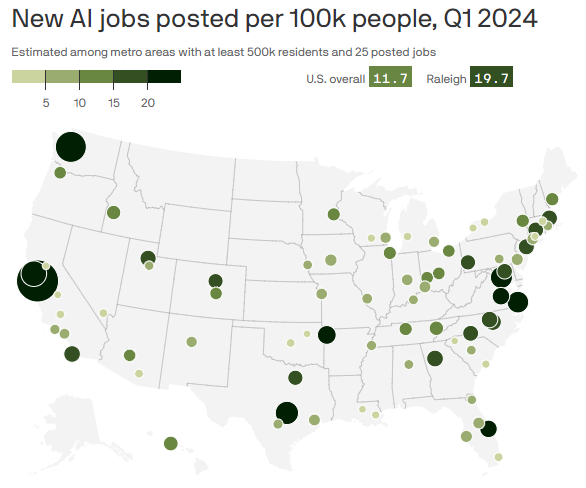Raleigh Metro Remains Competitive Against Peer Cities
By Ted Abernathy, Managing Partner of Economic Leadership LLC
The past 18 months have tested the strength and resilience of our regional economy, and I know that is an understatement. Disruption has been the watchword and accelerated change has permeated almost every aspect of our business and personal lives. As the summer of 2021 ends, the Delta variant surge, acute labor shortages, and supply chain chaos are reminders that we will continue to face stormy headwinds for the foreseeable future.
The Raleigh Metropolitan Statistical Area (MSA) has weathered the storm better than many expected. Despite continued challenges, especially in the Leisure and Hospitality and Education and Health Services sectors, other parts of the local economy have held steady and even grown. Through the pandemic Professional and Technical Service and Trade, Transportation and Utilities sectors have added workers. A recent surge in the Construction sector has resulted in almost five percent overall job growth since the month before the pandemic started. The region’s economic inertia entering the recession, the composition of the economy and record-setting economic development success throughout the pandemic has helped mitigate the overall impacts.
A regional opportunities and threat analysis two year ago would have identified technological shifts, changing work expectations, and demographic and societal transformations as challenges. It would also have identified every region’s challenge to find enough workers with the right skills. The Research Triangle Region’s first strategic plan in 2004 was entitled Staying on Top-Winning the Job Wars of the Future. We have known for two decades that our region’s ability to continue to attract the best and brightest was critical to our success. Maintaining a very high quality of life, with affordable cost of living and cost of doing business, is a big competitive advantage.
The two key opportunities for Raleigh, and the broader Research Triangle Region, lie in our industry strengths and the region’s broad competitiveness. In that first 2004 plan, industries were identified where the region had world-class university assets and key businesses that would create the foundation for future growth. Today the region’s advantages seem obvious, but at the time an economic development strategy to grow pharmaceuticals, pervasive computing (software, gaming, imaging), informatics (big data and data analytics), biological agents and infectious disease, agriculture biotechnology was bold. In 2021 it is hard to imagine our region without thinking about the major employers in these industries.
Each year Wake Economic Development releases a report on the region’s competitiveness compared to recent competitor metros and the nation’s top 100 metros. The analysis includes five individual multi-factor indexes and a composite index. Over 100 individual indices are used in the calculation. Once again, in 2021 the Raleigh MSA came out as the most competitive region in the country. The five indexes are summarized below. Raleigh ranked first in the Costs and Business Climate, Future and Talent Indexes and in the top 20 in the other two.
- Momentum Index- What is the metro’s economic inertia, measuring gains in population, jobs, wages, GDP, productivity, advanced industry jobs and recent investments in talent
- Future Index- What can you expect in the next decade. What are the economic projections, dependency ratios, how is the infrastructure, what does the talent pipeline look like and is there job growth in growing industries?
- Global Index- Measures of FDI, exports, foreign owned businesses, and immigration
- Talent- Measures of labor growth, labor force participation, educational attainment, cost of living, investments in education.
- Cost & Climate- Measures of business costs, taxation, regulation, legal environment, building energy and occupancy costs and crime.
Both Charlotte and Durham also ranked in the top 10 nationally, joining Salt Lake City, Austin, Seattle, Atlanta, Dallas, Nashville, and Charleston SC.
Moving forward we plan to add two additional indexes to keep up with evolving site selection concerns. The first is a Quality-of-Life Index that will include factors like home affordability, commuting times, access to recreation, crime, and access to health. The second is a Diversity-Equity-Inclusive Index.
Hopefully sometime soon we will enter the post-pandemic phase. When we do, many things will have changed. Remote work, and remote everything else will be more common than pre-pandemic. Consumer behavior habits have changed. Businesses will be more focused on redundancy, productivity, and risk. Data analytics will be even more important. An easy future prediction is that regions that are strong in technology and health will have an advantage. Affordable regions with low cost of doing business and a high-quality life will have an advantage. Regions with innovation assets like strong entrepreneurial ecosystems and world-class research universities will have an advantage. Finally, regions that have clear economic development strategies and talented people will continue to top lists and prosper.
Each year Wake County Economic Development commissions a study comparing the Raleigh metro to 100 of the largest metros in the US across 260 indicators comprising five indexes. We will release the 2021 Metro Comparisons Publication winter 2021. In the meantime, please review the 2020 publication here.






